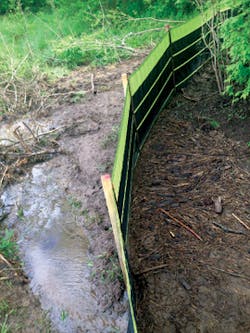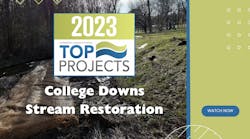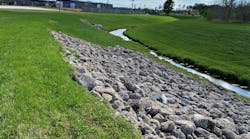In Part 4 of the concluding series about sediment and erosion control products and site-based applications, Erosion Control author Linda Robinson researches a Tennessee highway widening project to present the latest sediment control methods utilized at construction sites.
In this final segment, Robinson introduces the Staged Release Silt Fence (manufactured by Silt-Saver) and illustrates its applications in a case study described within the following transportation infrastructure construction project.
Continue with this article as it explains sediment control methods utilizing this geotextile product, its design variables—from the composition of its materials to the signature color of this product—as well as the site-based applications for which it is intended.
Getting the Upper Hand on Sediment (Part 4) By Linda Robinson
Specialized products solve a range of construction site challenges. Twelve Lanes Across the Bridge Todd Felts, distributor and project manager with England Erosion, Seed & Supply in Nashville, works on many TDOT highway and bridge construction projects. He has been trying a new product, Staged Release Silt Fence (SRSF), manufactured by Silt-Saver. “Roger [Singleton] came up with the first geotextile designed specifically for vertical placement to control silt and sediment using different sieve-sized geotextiles all made up into one roll,” Felts explains. “It holds the solids to be retained while allowing for the release of stormwater runoff. We have this new SRSF on three different TDOT projects in Tennessee right now.” One Bedford County TDOT project calls for construction of a concrete I-beam bridge. This was a project, Todd says, where the SRSF especially made difference. “All silt fence is placed to retain sediment, but what is unique about this product is that, as the amount of water or depth of the runoff increases, the speed of water passing through the fence increases. And this decreases the likelihood of the system being knocked down from the pressure of the water against it or failing resulting in a sediment release.” All three of the TDOT highway projects where the SRSF are installed are located in middle Tennessee counties. In addition to the Bedford County project, Felts and Christopher Karper, CPESC, a senior engineer with Lochner Engineering, installed the SRSF on sites located in Montgomery and Williamson Counties as well. And in an area where a good rainstorm can come up at any time, it’s good to know the fence has been installed and is ready. The Williamson County site, which Karper oversees, consists of widening Highway I-65 to help relieve high traffic congestion and improve public safety. In addition to other construction, a bridge over I-65 that will be widened from two lanes to ten 12-foot lanes. The work will be completed in stages to accommodate the traffic flows. An additional two bridges will be constructed, also in stages. Highway lanes will provide access to a new subdivision, and new power poles and water and sewer lines will be installed. Comcast and AT&T fiber optics will also be relocated. “I assist with scheduling inspection assignments with the contractors’ activities project wide,” explains Karper. “We have used a combination of rock check dams, enhanced rock check dams, sand bags, sediment filter bags, Type A catch basins, geotextile, temporary sediment tubes, and temporary mulch, bales, silt fence, and other silt fence with backing.” The SRSF has been installed, and to evaluate its performance Karper says he’s just waiting for a “good rain event” to see how it stands up to pressure. He adds that on a site this large, erosion and sediment control is a daily issue. “We started with 110 outfalls, and I have added an additional four or so. You have to know how the stormwater runoff affects each outfall and adjust your erosion control measures accordingly. Also, as the project is constructed, runoff is affected and additional adjustments are needed in many areas.” Silt-Saver president and owner Roger Singleton says these types of variables are what the SRSF was designed to accommodate. He explains that the SRSF is designed to release excessive amounts of stormwater before the point of being overtopped. The fence includes belts woven within the fabric, between each individual flow stage, for attachment and to provide additional linear strength. The belts provide the structural integrity to support the linear pressure of the stormwater without the need for wire. This reduces undermining or total system knockdown due to the hydrostatic pressure created by impoundment. On large highway projects like these, Felts points out, several companies are working onsite all at once, in addition to the highway traffic. On congested sites like this, the Silt-Saver product really shines—literally. “Bright green is the signature color of Silt-Saver, and each band is that bright green, as well as the top section of geotextile. So you get the added benefit of delineation,” he explains. “Silt fences are run over all the time by machinery because it is sometimes hard to see or gets lost from the operator’s position. This product accomplishes both purposes on the construction site, without duplicating resources, material, and man hours. “In my book, this helps to decrease the cost of overall construction and shows the public that our industry is responding to the real concerns about the rising costs of environmentally conscious construction practices.”Getting the Upper Hand on Sediment (Part 4) By Linda Robinson
Specialized products solve a range of construction site challenges.
Twelve Lanes Across the Bridge
Todd Felts, distributor and project manager with England Erosion, Seed & Supply in Nashville, works on many TDOT highway and bridge construction projects. He has been trying a new product, Staged Release Silt Fence (SRSF), manufactured by Silt-Saver.
“Roger [Singleton] came up with the first geotextile designed specifically for vertical placement to control silt and sediment using different sieve-sized geotextiles all made up into one roll,” Felts explains. “It holds the solids to be retained while allowing for the release of stormwater runoff. We have this new SRSF on three different TDOT projects in Tennessee right now.”
One Bedford County TDOT project calls for construction of a concrete I-beam bridge. This was a project, Todd says, where the SRSF especially made difference.
“All silt fence is placed to retain sediment, but what is unique about this product is that, as the amount of water or depth of the runoff increases, the speed of water passing through the fence increases. And this decreases the likelihood of the system being knocked down from the pressure of the water against it or failing resulting in a sediment release.”
All three of the TDOT highway projects where the SRSF are installed are located in middle Tennessee counties. In addition to the Bedford County project, Felts and Christopher Karper, CPESC, a senior engineer with Lochner Engineering, installed the SRSF on sites located in Montgomery and Williamson Counties as well. And in an area where a good rainstorm can come up at any time, it’s good to know the fence has been installed and is ready.
The Williamson County site, which Karper oversees, consists of widening Highway I-65 to help relieve high traffic congestion and improve public safety. In addition to other construction, a bridge over I-65 that will be widened from two lanes to ten 12-foot lanes. The work will be completed in stages to accommodate the traffic flows. An additional two bridges will be constructed, also in stages. Highway lanes will provide access to a new subdivision, and new power poles and water and sewer lines will be installed. Comcast and AT&T fiber optics will also be relocated.
“I assist with scheduling inspection assignments with the contractors’ activities project wide,” explains Karper. “We have used a combination of rock check dams, enhanced rock check dams, sand bags, sediment filter bags, Type A catch basins, geotextile, temporary sediment tubes, and temporary mulch, bales, silt fence, and other silt fence with backing.”
The SRSF has been installed, and to evaluate its performance Karper says he’s just waiting for a “good rain event” to see how it stands up to pressure. He adds that on a site this large, erosion and sediment control is a daily issue. “We started with 110 outfalls, and I have added an additional four or so. You have to know how the stormwater runoff affects each outfall and adjust your erosion control measures accordingly. Also, as the project is constructed, runoff is affected and additional adjustments are needed in many areas.”
Silt-Saver president and owner Roger Singleton says these types of variables are what the SRSF was designed to accommodate. He explains that the SRSF is designed to release excessive amounts of stormwater before the point of being overtopped. The fence includes belts woven within the fabric, between each individual flow stage, for attachment and to provide additional linear strength. The belts provide the structural integrity to support the linear pressure of the stormwater without the need for wire. This reduces undermining or total system knockdown due to the hydrostatic pressure created by impoundment.
On large highway projects like these, Felts points out, several companies are working onsite all at once, in addition to the highway traffic. On congested sites like this, the Silt-Saver product really shines—literally. “Bright green is the signature color of Silt-Saver, and each band is that bright green, as well as the top section of geotextile. So you get the added benefit of delineation,” he explains. “Silt fences are run over all the time by machinery because it is sometimes hard to see or gets lost from the operator’s position. This product accomplishes both purposes on the construction site, without duplicating resources, material, and man hours.
“In my book, this helps to decrease the cost of overall construction and shows the public that our industry is responding to the real concerns about the rising costs of environmentally conscious construction practices.”






